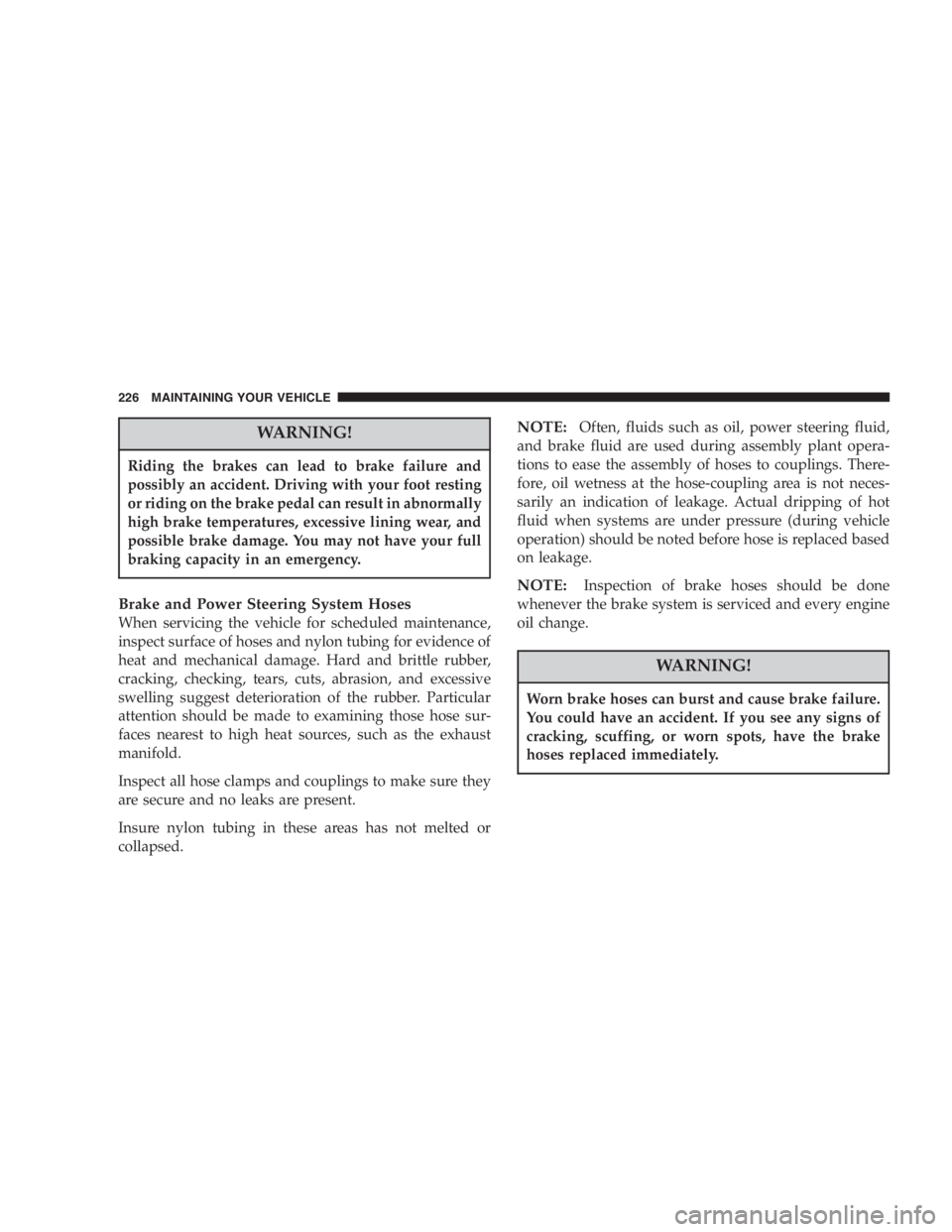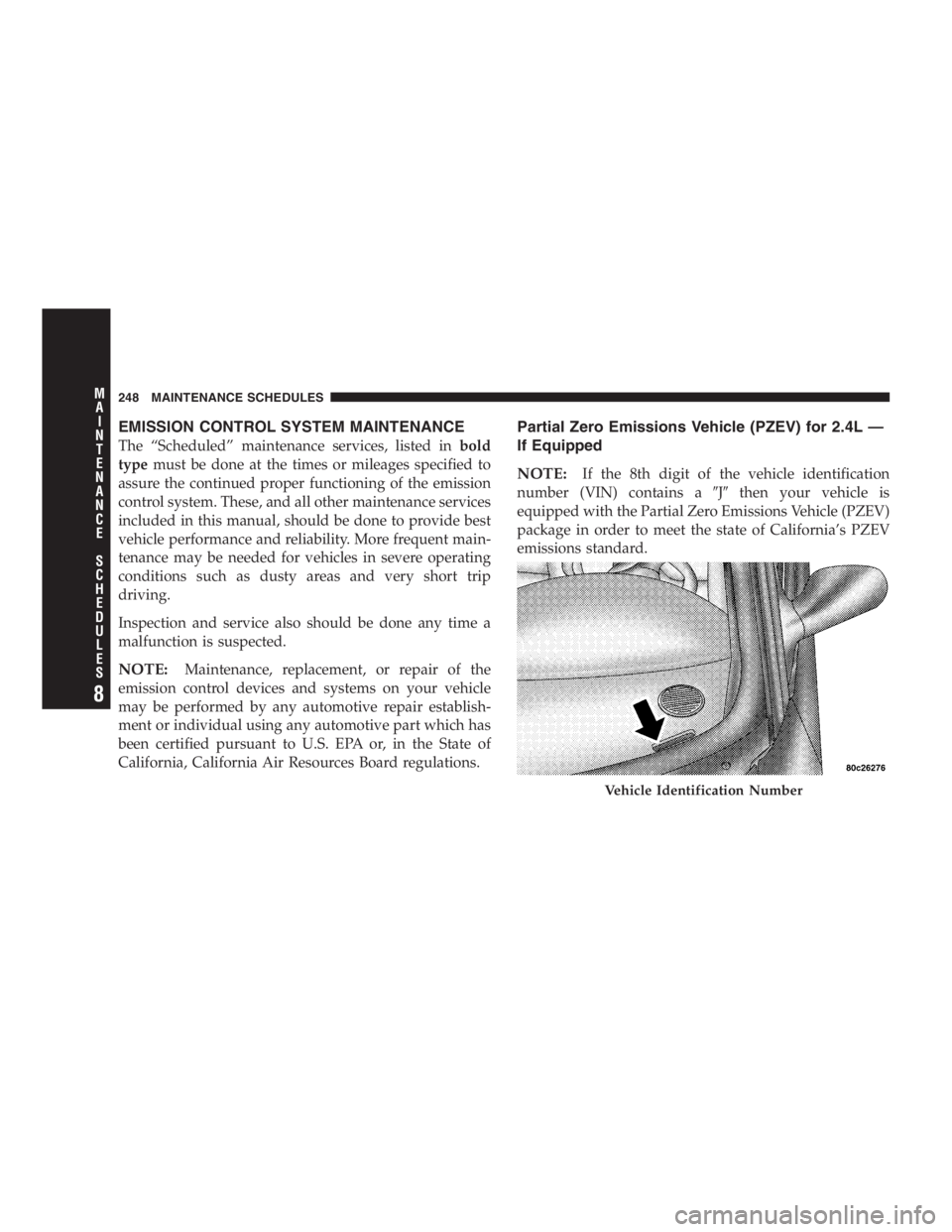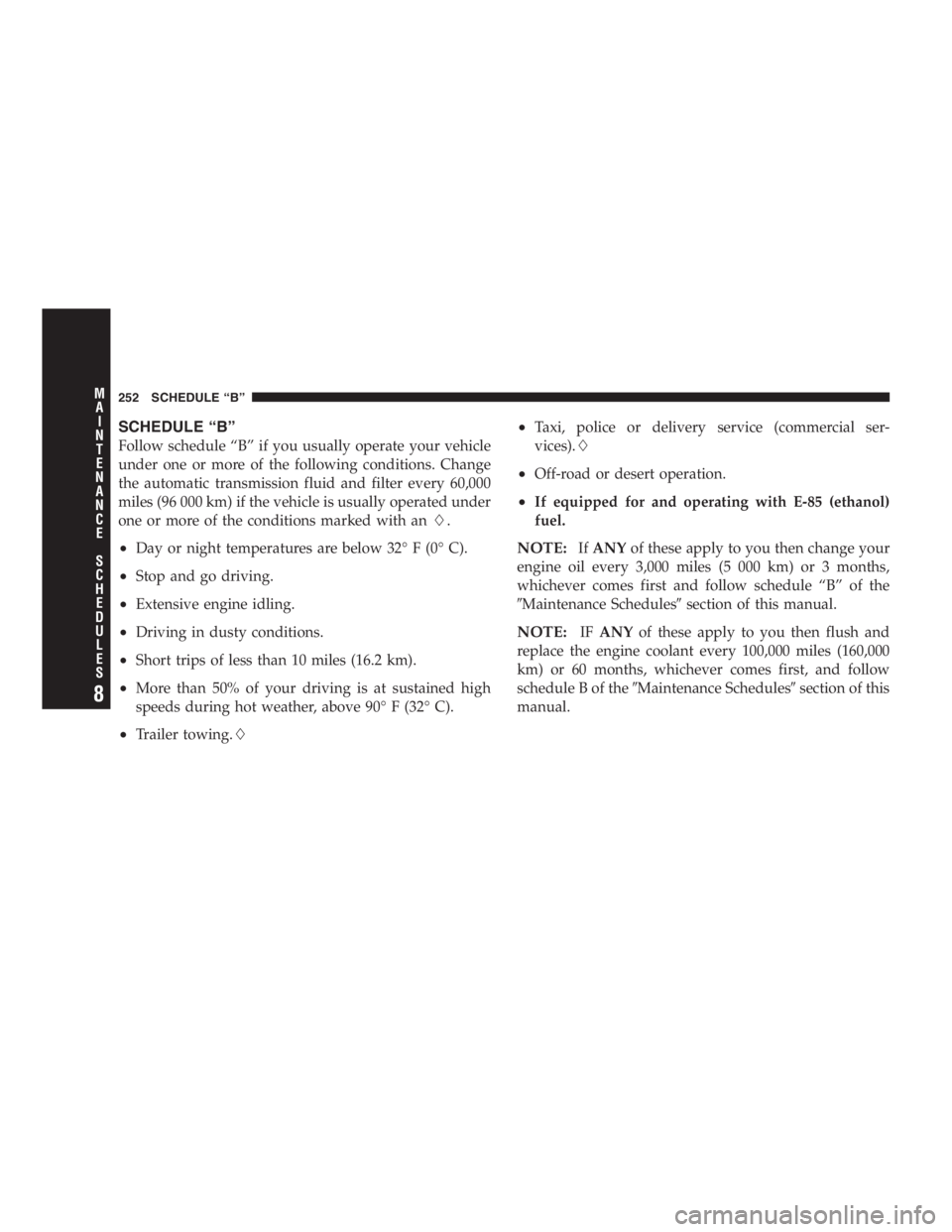Page 226 of 293

WARNING!
Riding the brakes can lead to brake failure and
possibly an accident. Driving with your foot resting
or riding on the brake pedal can result in abnormally
high brake temperatures, excessive lining wear, and
possible brake damage. You may not have your full
braking capacity in an emergency.
Brake and Power Steering System Hoses
When servicing the vehicle for scheduled maintenance,
inspect surface of hoses and nylon tubing for evidence of
heat and mechanical damage. Hard and brittle rubber,
cracking, checking, tears, cuts, abrasion, and excessive
swelling suggest deterioration of the rubber. Particular
attention should be made to examining those hose sur-
faces nearest to high heat sources, such as the exhaust
manifold.
Inspect all hose clamps and couplings to make sure they
are secure and no leaks are present.
Insure nylon tubing in these areas has not melted or
collapsed.
NOTE:Often, fluids such as oil, power steering fluid,
and brake fluid are used during assembly plant opera-
tions to ease the assembly of hoses to couplings. There-
fore, oil wetness at the hose-coupling area is not neces-
sarily an indication of leakage. Actual dripping of hot
fluid when systems are under pressure (during vehicle
operation) should be noted before hose is replaced based
on leakage.
NOTE:Inspection of brake hoses should be done
whenever the brake system is serviced and every engine
oil change.
WARNING!
Worn brake hoses can burst and cause brake failure.
You could have an accident. If you see any signs of
cracking, scuffing, or worn spots, have the brake
hoses replaced immediately.
226 MAINTAINING YOUR VEHICLE
Page 229 of 293

Procedure For Checking Fluid Level
The fluid level in the automatic transaxle should be
checked whenever the vehicle is serviced. Operation with
an improper fluid level will greatly reduce the life of the
transaxle and of the fluid.
To properly check the automatic transaxle fluid level, the
following procedure must be used:
•The vehicle must be on level ground.
•The engine should be running at curb idle speed for a
minimum of 60 seconds.
•Fully apply parking brake.
•Place the gear selector momentarily in each gear
position ending with the lever in P (PARK).
•Wipe the dipstick clean and reinsert until seated.
Remove dipstick and note reading.
•If the fluid is cold (80°F/27°C), the reading should be
in the cross hatched area marked“COLD”(between
the lower two holes in the dipstick).
•If the fluid is hot (180°F/82°C), the reading should be
in the cross hatched area marked”HOT”(between the
upper two holes in the dipstick).
•If the fluid level shows low, add sufficient transmis-
sion fluid to bring to the proper level.
CAUTION!
Do not overfill. Dirt and water in the transaxle can
cause serious damage. To prevent dirt and water
from entering the transaxle after checking or replen-
ishing fluid, make certain that the dipstick cap is
seated properly.
Fluid and Filter Changes
Automatic transmission fluid and filter should be
changed as follows:
Maintenance schedule“A”—No change necessary.
Maintenance schedule“B”—Every 60,000 miles (96 000
km) change fluid and filter under the following condi-
tions:
MAINTAINING YOUR VEHICLE 229
7
Page 248 of 293

EMISSION CONTROL SYSTEM MAINTENANCE
The“Scheduled”maintenance services, listed inbold
typemust be done at the times or mileages specified to
assure the continued proper functioning of the emission
control system. These, and all other maintenance services
included in this manual, should be done to provide best
vehicle performance and reliability. More frequent main-
tenance may be needed for vehicles in severe operating
conditions such as dusty areas and very short trip
driving.
Inspection and service also should be done any time a
malfunction is suspected.
NOTE:Maintenance, replacement, or repair of the
emission control devices and systems on your vehicle
may be performed by any automotive repair establish-
ment or individual using any automotive part which has
been certified pursuant to U.S. EPA or, in the State of
California, California Air Resources Board regulations.
Partial Zero Emissions Vehicle (PZEV) for 2.4L—
If Equipped
NOTE:
If the 8th digit of the vehicle identification
number (VIN) contains a�J�then your vehicle is
equipped with the Partial Zero Emissions Vehicle (PZEV)
package in order to meet the state of California’s PZEV
emissions standard.
Vehicle Identification Number
248 MAINTENANCE SCHEDULES
8
M
A
I
N
T
E
N
A
N
C
E
S
C
H
E
D
U
L
E
S
Page 249 of 293

NOTE:There are specific instructions regarding when
to change the ignition cables and spark plugs with the
PZEV package in this section. This applies to both
maintenance schedule A and B and will be marked with
an ** or ***.
MAINTENANCE SCHEDULES
There are two maintenance schedules that show the
requiredservice for your vehicle.
First is Schedule“B”. It is for vehicles that are operated
under the conditions that are listed below and at the
beginning of the schedule.
•Day or night temperatures are below 32°F(0°C).
•Stop and go driving.
•Extensive engine idling.
•Driving in dusty conditions.
•Short trips of less than 10 miles (16 km).
•More than 50% of your driving is at sustained high
speeds during hot weather, above 90°F (32°C).
•Trailer towing.�
•Taxi, police, or delivery service (commercial ser-
vice).�
•Off-road or desert operation.
•If equipped for and operating with E-85 (ethanol)
fuel.
NOTE:IfANYof these apply to you then change your
engine oil every 3,000 miles (5,000 km) or 3 months,
whichever comes first and follow schedule B of the
“Maintenance Schedules”section of this manual.
NOTE:IFANYof these apply to you then flush and
replace the engine coolant every 100,000 miles (160,000
km) or 60 months, whichever comes first, and follow
schedule B of the�Maintenance Schedules�section of this
manual.
NOTE:Most vehicles are operated under the conditions
listed for Schedule�B�.
Second is Schedule“A”. It is for vehicles that are not
operated under any of the conditions listed under Sched-
ule�B�.
MAINTENANCE SCHEDULES 249
8
M
A
I
N
T
E
N
A
N
C
E
S
C
H
E
D
U
L
E
S
Page 252 of 293

SCHEDULE“B”
Follow schedule“B”if you usually operate your vehicle
under one or more of the following conditions. Change
the automatic transmission fluid and filter every 60,000
miles (96 000 km) if the vehicle is usually operated under
one or more of the conditions marked with an�.
•Day or night temperatures are below 32°F(0°C).
•Stop and go driving.
•Extensive engine idling.
•Driving in dusty conditions.
•Short trips of less than 10 miles (16.2 km).
•More than 50% of your driving is at sustained high
speeds during hot weather, above 90°F (32°C).
•Trailer towing.�
•Taxi, police or delivery service (commercial ser-
vices).�
•Off-road or desert operation.
•If equipped for and operating with E-85 (ethanol)
fuel.
NOTE:IfANYof these apply to you then change your
engine oil every 3,000 miles (5 000 km) or 3 months,
whichever comes first and follow schedule“B”of the
�Maintenance Schedules�section of this manual.
NOTE:IFANYof these apply to you then flush and
replace the engine coolant every 100,000 miles (160,000
km) or 60 months, whichever comes first, and follow
schedule B of the�Maintenance Schedules�section of this
manual.
252 SCHEDULE“B”
8
M
A
I
N
T
E
N
A
N
C
E
S
C
H
E
D
U
L
E
S
Page 261 of 293
Miles 144,000 147,000 150,000
(Kilometers) (232 000) (237 000) (241 000)
Change engine oil and engine oil filter, if not replaced at 3
months.XXX
Inspect theair cleaner filterand replace if necessary.* X X
Replace theair cleaner filter.X
Replace thespark plugson the 2.4 liter engine. ** X
Inspect the front and rear brake pads, linings, rotors, rear drums
and shoes.X
Check and replace, if necessary, thePCV valve.*‡X
Rotate the tires.X
* This maintenance is recommended by the manufacture
to the owner but is not required to maintain the emis-
sions warranty.
** Except for the 2.4 liter Partial Zero Emissions Vehicle
(PZEV).
*** 2.4 liter PZEV only.‡This maintenance is not required if previously replaced.
Inspection and service should also be performed anytime
a malfunction is observed or suspected. Retain all re-
ceipts.
SCHEDULE“B”261
8
M
A
I
N
T
E
N
A
N
C
E
S
C
H
E
D
U
L
E
S
Page 267 of 293
Miles144,000 150,000
(Kilometers) (232 000) (241 000)
[Months][144] [150]
Change engine oil and engine oil filter. X X
Inspect theair cleaner filterand replace if required.* X
Replace theair cleaner filter.X
Inspect the front and rear brake pads, linings, rotors, rear drums and shoes. X
Check and replace, if necessary, thePCV valve.*‡X
Replace theengine timing belton 2.4 liter engine.*** X
Replace thespark plugson 2.4 liter engine. ** X
Rotate the tires. X X
* This maintenance is recommended by the manufacture
to the owner but is not required to maintain the emis-
sions warranty.
** Except for the 2.4 liter Partial Zero Emissions Vehicle
(PZEV).
*** 2.4 liter PZEV only.‡This maintenance is not required if previously replaced.
Inspection and service should also be performed anytime
a malfunction is observed or suspected. Retain all re-
ceipts.
SCHEDULE“A”267
8
M
A
I
N
T
E
N
A
N
C
E
S
C
H
E
D
U
L
E
S
Page 268 of 293
WARNING!
You can be badly injured working on or around a
motor vehicle. Do only that service work for which
you have the knowledge and the right equipment. If
you have any doubt about your ability to perform a
service job, take your vehicle to a competent me-
chanic.
268 SCHEDULE“A”
8
M
A
I
N
T
E
N
A
N
C
E
S
C
H
E
D
U
L
E
S